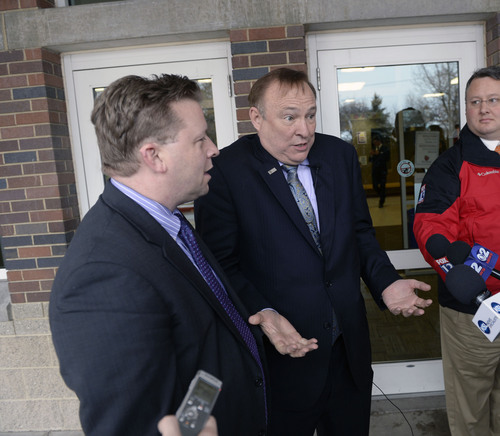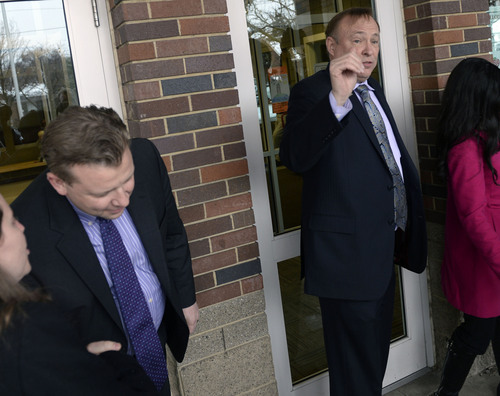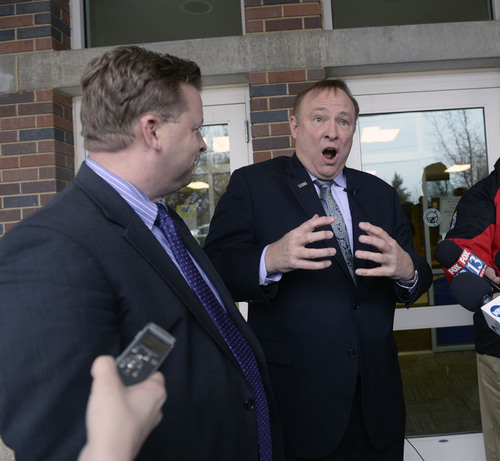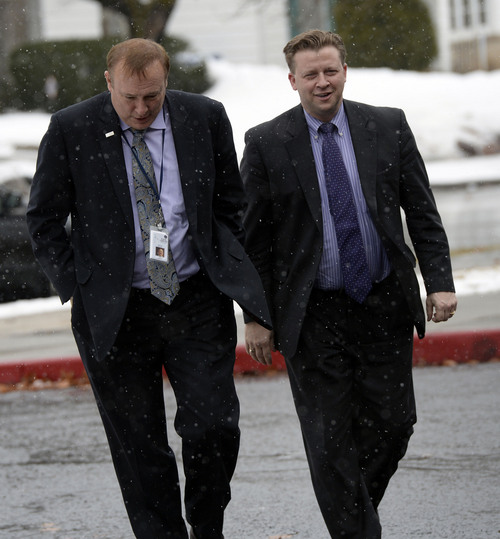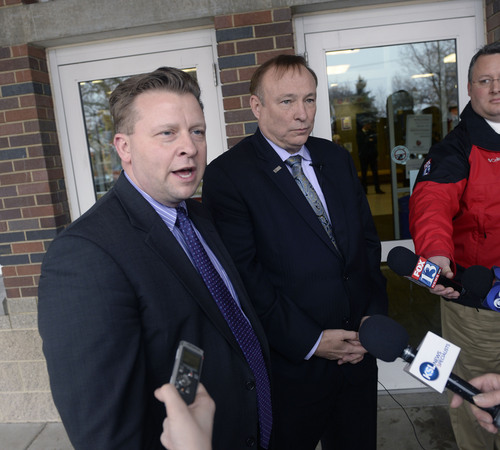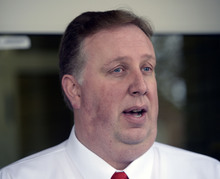This is an archived article that was published on sltrib.com in 2014, and information in the article may be outdated. It is provided only for personal research purposes and may not be reprinted.
A cafeteria manager has been placed on paid administrative leave as the Salt Lake City School District investigates the seizure of school lunches from up to 40 young students with unpaid meal tabs.
The lunches were taken away Tuesday at Uintah Elementary, a move that has sparked outcry from parents, lawmakers and outraged observers who have created a sensation on social media.
More employees could be put on leave as well, depending on what the investigation uncovers, said district Superintendent McKell Withers.
While the district initially said the decision to take the lunches was made by a district-level child nutrition manager, spokesman Jason Olsen now says that is under investigation.
Sens. Jim Dabakis, D-Salt Lake City, and Todd Weiler, R-Woods Cross, visited the school Thursday, holding a press conference outside before joining kids for meals inside. Weiler called the incident "bullying."
"To me this rises to the level of bullying," Weiler said. "Children were humiliated."
Weiler called for a firing.
" I think it's an abuse of power," he said. "This person came into a school and used her power to humiliate and embarrass children and I think we ought to draw a line and say that's not acceptable behavior."
After their lunches were taken, the children were given a snack of fruit and milk.
Withers said "termination is on the table," depending on what the investigation uncovers. He said he's "incredibly disappointed" that anyone would switch a student's lunch once it's already in that child's hands.
Olsen said the district, which has apologized, is still investigating whether any policies need to change.
He said Uintah school officials have received threats. "I don't know how many or the nature of the threats."
—
Why take away lunches? • The lunch seizures appear to stem from how the Salt Lake City district at times identifies which kids are in debt — while they are checking out in front of friends.
Olsen said the Uintah students had to go through the lunch line before their balances were checked to give cafeteria workers a chance to make sure they had chosen foods that comply with federal school lunch rules.
But when students in debt reached that point and couldn't have their meals, Olsen said, the lunches couldn't be given to other students. Staffers have to throw such food away.
Uintah is not in a low-income neighborhood, and only about 11 percents of its students qualify for free or reduced price lunches.
Of the Salt Lake Valley's four largest districts, only Salt Lake City has been using the point-of-sale strategy. Withers said it shouldn't have happened, and the district is looking into whether it has been used at other schools.
In the Granite, Jordan and Canyons districts, children at the end of their various grace periods are identified before they enter the lunchroom and are given alternative meals when they arrive.
Former district lunch worker Pam Gomez said public seizures in Salt Lake City schools have been done routinely on a smaller scale.
"The kitchen managers are aghast every time they have to do that," said Gomez, who retired two years ago after working in the district for seven years. "You have children crying. You know they get embarrassed because it happens in front of everybody."
She added, "It's sad for those kids, but at least now the policy is out in the open."
Principals in the Canyons School District keep close tabs on kids' accounts and know if they're empty before kids head in for lunch, said spokeswoman Jennifer Toomer-Cook.
"We do not take food away from children. That is not our policy," she said.
Olsen reiterated Thursday that physically taking lunches away from students was a mistake. Withers said students in debt should be identified before they get their food, not after.
—
'We are better than this' • The lunch seizures spotlighted a practice that, while not evenly applied at all Utah schools, warrants fixing, said David Kirkham, a tea party leader in Provo who ran for governor in 2012.
"My wife and I were shocked and talking about it yesterday when my kids turned to us and said, 'They've done this for a long time,'" he said.
Over the years Kirkham's twin 17-year-old boys have seen lunch taken from students in Provo School District's elementary and secondary schools.
"I don't think people are trying to cheat the school out of money," said Kirkham. "There has got to be a better solution. It's all over the news and just going to embarrass our state. We are better than this."
Dabakis and Weiler said they might work together to run legislation this session aimed at ensuring Utah children don't go hungry at school. Dabakis said he couldn't yet provide any further details.
Giving students in debt a "snack meal" of fruit and milk is also done in other school districts.
But Jeff Reinert, whose daughter attends kindergarten at Salt Lake City's Beacon Heights Elementary, thinks that should change in his district.
His daughter received an orange and milk for lunch recently because her parents owed about $10. Reinert said he and his wife thought they had signed up for e-mail notifications of a low balance, but didn't receive one. They didn't notice a letter sent home with her one day before her lunch was withheld, he said.
He said he feels bad for "dropping the ball," but wishes the district had fined him or imposed another penalty.
"Any other option rather than her not being able to eat on that day I would have accepted," Reinert said.
Olsen said the Salt Lake City School District is also investigating its notification procedures and will make sure they are working correctly.
Sven Haynes, a parent at Uintah Elementary, said he had trouble working the district's electronic payment system, which changed this year, despite being an IT professional. He said his daughter, a kindergartner, was given fruit and milk for lunch one day at the beginning of the school year because she didn't have enough money in her account.
Haynes said cafeteria staff were heartbroken when told Tuesday they had to take kids' lunches.
"The school district has decided to nickel and dime these kids and literally bully them over their lunch money," Haynes said.
—
Tallying unpaid tabs • Olsen said Thursday he does not know how much the district carries in unpaid meal tabs.
Granite now has about $40,000 in outstanding lunch fees, which is absorbed into the price of lunches, said district spokesman Ben Horsley.
The district usually continues to provide full lunches to students who have fallen behind in payments while it reaches out to parents with automatic electronic notices, then phone calls.
In the rare cases when parents simply don't respond, schools still feed the student, typically with milk, fruit and leftovers.
"We would never want to confront a student," Horsley said. "Students are not responsible for their school lunch payments. Their parents are."
The Jordan School District ended last year with $3,436 in unpaid meals, said nutrition director Jana Cruz.
"We really don't have a problem collecting money from parents," she said. "But Salt Lake is a lower-income district than we are."
Jordan also funds lunch clerks whose sole responsibility is monitoring student accounts, Cruz said.
Both Canyons and Jordan eventually, after grace periods, switch to giving children in arrears fruit and milk.
But most years, Canyons ends up with a $9,000 surplus that it uses to cover families with meal debt, said Toomer-Cook. Principals have budgets and discretion over how much credit to extend.
"At some schools it could be $6 and at others $10 or $20," she said.
School lunch is federally subsidized, and in Utah, lunches are further underwritten by liquor sales tax revenue.
"But even with this money, food and labor is very expensive. Students still need to pay their lunch bill," said Cruz.



